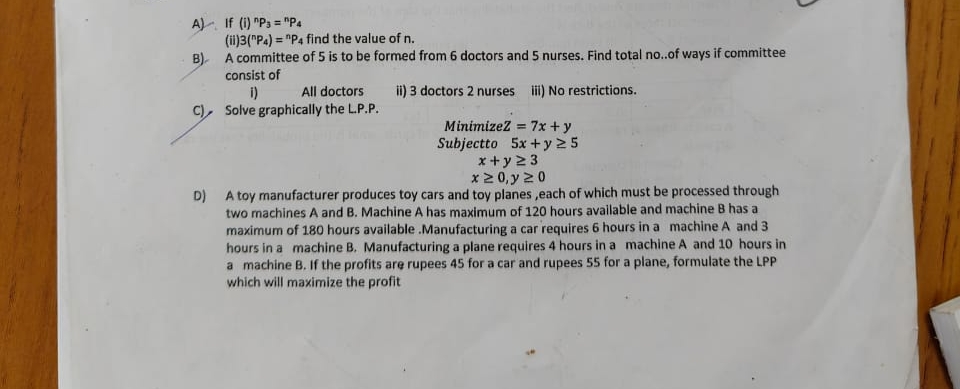A) If (i) nP3 = nP4 find the value of n. (ii) (3!)(P4) = ? B) A committee of 5 is to be formed from 6 doctors and 5 nurses. Find total no. of ways if committee consists of i) All d... A) If (i) nP3 = nP4 find the value of n. (ii) (3!)(P4) = ? B) A committee of 5 is to be formed from 6 doctors and 5 nurses. Find total no. of ways if committee consists of i) All doctors ii) 3 doctors 2 nurses iii) No restrictions. C) Solve graphically the L.P.P. Minimize Z = 7x + y Subjectto 5x + y ≥ 5 x + y ≥ 3 x ≥ 0, y ≥ 0 D) A toy manufacturer produces toy cars and toy planes, each of which must be processed through two machines A and B. Machine A has maximum of 120 hours available and machine B has a maximum of 180 hours available. Manufacturing a car requires 6 hours in machine A and 3 hours in machine B. Manufacturing a plane requires 4 hours in machine A and 10 hours in machine B. If the profits are rupees 45 for a car and rupees 55 for a plane, formulate the LPP which will maximize the profit.

Understand the Problem
The question is asking to solve a set of mathematical problems that involve combinations, linear programming, and optimization based on given conditions for each part. Specifically, it seeks to find value(s) for n, calculate committee formations, and maximize profit for manufacturing processes.
Answer
The value of \( n \) is \( 4 \); combinations are \( 6 \), \( 200 \), and \( 462 \). Profit maximization involves LPP analysis.
Answer for screen readers
- The value of ( n ) is ( 4 ).
- Total combinations:
- Case i: ( 6 )
- Case ii: ( 200 )
- Case iii: ( 462 )
- Optimal solution for LPP needs graphical analysis.
- Profit maximization values can be derived from the constraints.
Steps to Solve
- Finding the value of ( n )
To find the value of ( n ) such that ( P_3 = P_4 ), we can use the formula for permutations.
Using the formula for permutations, we have:
[ P_n^r = \frac{n!}{(n-r)!} ]
Set up the equation as follows:
[ P_n^3 = P_n^4 \implies \frac{n!}{(n-3)!} = \frac{n!}{(n-4)!} ]
- Solving the equations for part A
Cancel ( n! ) from both sides:
[ (n-3)! = (n-4)! ]
This simplifies to:
[ n-3 = 1 \implies n = 4 ]
- Combinations of doctors and nurses for part B
A committee of 5 needs to be formed from 6 doctors and 5 nurses. The combinations for each case are calculated as follows:
- Case i: All doctors
[ \text{Ways} = \binom{6}{5} = 6 ]
- Case ii: 3 doctors and 2 nurses
[ \text{Ways} = \binom{6}{3} \times \binom{5}{2} ]
Calculating those:
[ \binom{6}{3} = 20 \quad \text{and} \quad \binom{5}{2} = 10 ]
Thus,
[ \text{Ways} = 20 \times 10 = 200 ]
- Case iii: No restrictions
For 5 people from 11 total (6 doctors + 5 nurses):
[ \text{Ways} = \binom{11}{5} = 462 ]
- Solving the Linear Programming Problem (LPP) for part C
Objective function to minimize:
[ Z = 7x + y ]
Constraints:
-
( 5x + y \geq 5 )
-
( x + y \geq 3 )
-
( x \geq 0 ), ( y \geq 0 )
-
Graphical Representation
Graph the lines represented by each constraint to find the feasible region and locate the vertices. Identify which vertex minimizes ( Z ).
- Optimizing the Profit for part D
Using the maximum hours of Machine A (180 hours) and available hours per task:
- Let ( x ) be the number of cars and ( y ) the number of planes.
The constraints and profit are set up as follows:
[ 6x + 4y \leq 180 \quad \text{(Machine A)} ] [ 3x + 10y \leq 120 \quad \text{(Machine B)} ] Maximize profit ( P = 45x + 55y ).
- The value of ( n ) is ( 4 ).
- Total combinations:
- Case i: ( 6 )
- Case ii: ( 200 )
- Case iii: ( 462 )
- Optimal solution for LPP needs graphical analysis.
- Profit maximization values can be derived from the constraints.
More Information
The value of ( n ) reveals how permutations relate to each other, while combinations indicate possible selections for the committee. Graphical solutions allow for visual understanding of feasible regions in linear programming.
Tips
- Misapplying permutation and combination formulas—always verify that the conditions fit.
- Not graphing constraints accurately in LPP—use precise plotting for better clarity of feasible regions.
AI-generated content may contain errors. Please verify critical information